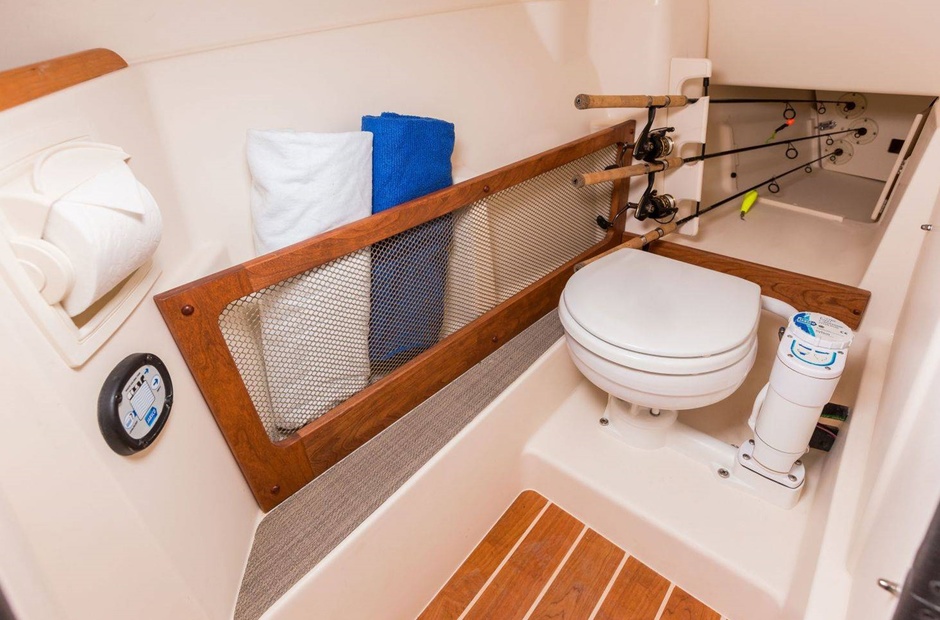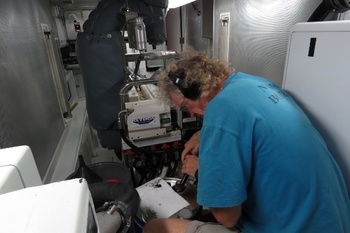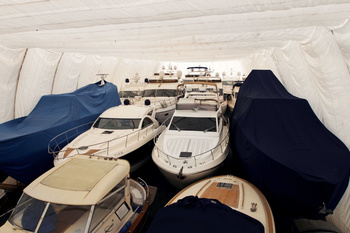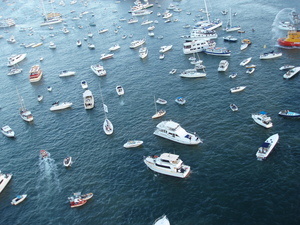Our Pearson 39-2 has had a Raritan PH II garbage on board for 30 years, but it has been malfunctioning recently. The yacht has been on shore for about 2 years. No one has used the latrine, of course. In fact, all that was needed to keep it in working order was to use it regularly for its intended purpose, then the seals would not collapse. It was possible to disassemble it, to replace replace replaceable parts (after all, ZIP in principle not expensive) and to finish on it. But considering the respectable age of the system, all associated fittings, in fact, also worn out.
The faecal water system is mounted quite typically: the outlet from the latrine went through a siphon to a three-way shut-off valve, which in turn directs the flow overboard or into a storage tank, from which you can roll overboard through a pump with a waste shredder, or to the receiving point in the marina. Both the inlet and outlet nozzle are overgrown with sediments. It was easy to determine the age of the yacht by the number of layers, so it was necessary to replace them. Because of the deposits the shredder worked accordingly - it was noisy as a tractor, but did not pump anything.
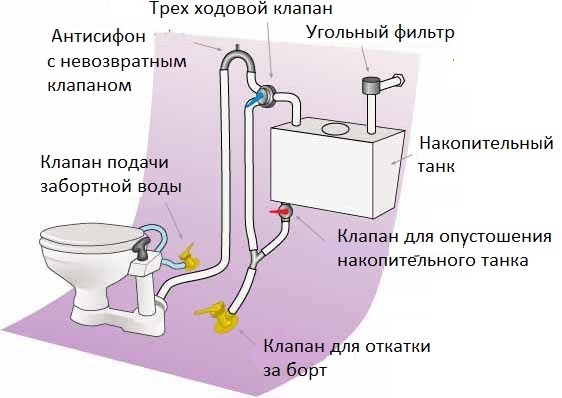
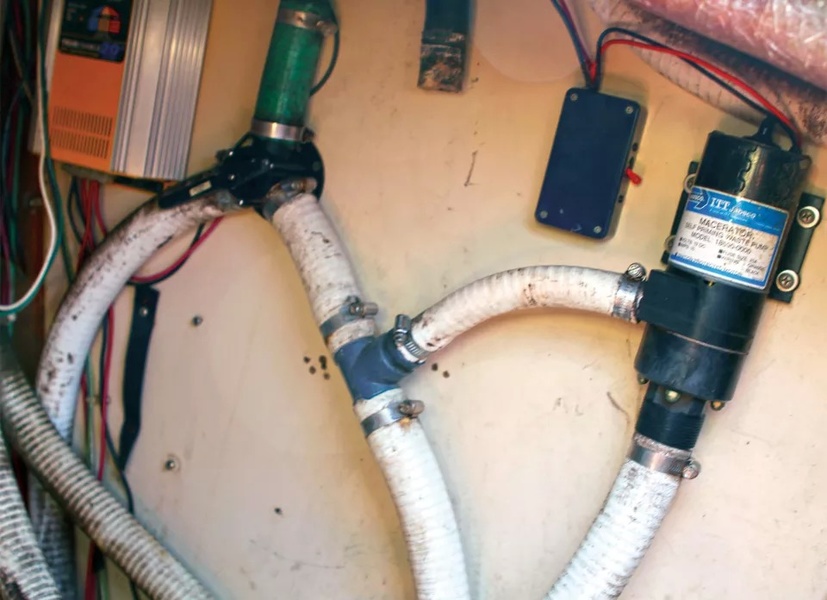
The deplorable state of the faecal system made my head crack as to whether it should be repaired or replaced. The plans were to stay on the yacht for a long time, and this circumstance did not fit into the overall picture. My choice depended on the continued comfort of being on board.
Keep it the same?
Rehabilitation of the system involves the purchase of new pipes, a three-way valve, shredder, antisyphon and other fittings. After the inspection it will be clear whether a set of replacement parts has to be purchased or whether it is easier to replace the entire set.
The advantages of leaving the old garage are:
- I have already dealt with this system and know what to do;
- the restoration of the system is guaranteed to solve my problems for the entire life of the yacht
- a lower cost of the whole idea.
The disadvantage of my manual pumped toilet is that it is unsuitable for guests and everyone who sees it for the first time.
In the end, after each use, there is a smell that seeps through the treacherous petal valve.
Replace it with a compost one?
Optionally, you can install a compost throne, then I can dismantle most of the pipeline and replace the faecal tank with something more useful, like an additional fuel tank. Many yachtsmen are very enthusiastic about compost litter and I started to get into this idea.
In the end, as I found out, the advantages were as follows:
- simplicity, no need to stretch out the pipeline system, and therefore no additional holes in the housing;
- no shredder pumps and an unfortunate storage tank.
The drawbacks were:
- shocking guests on board, who would be surprised to see such a thing; -
insects appearing if poor quality raw materials are used for compost;
- regular emptying of the liquid waste tank, solid waste, eventually also has to be disposed of.
Whether you decide legally or not, I am sure you will do the right thing;
- also, do not forget about the cost of bacteria and the environment for them, as well as the unit itself.
Despite all the disadvantages of storage tanks, most marinas have the option of rolling back their contents at any convenient time. Or you can quickly jump out into the three-mile zone and do all your dirty work by emptying the storage tank, and the problem is solved, but running around the bank with a bucket of compost is clearly not what you want to do when you're resting.
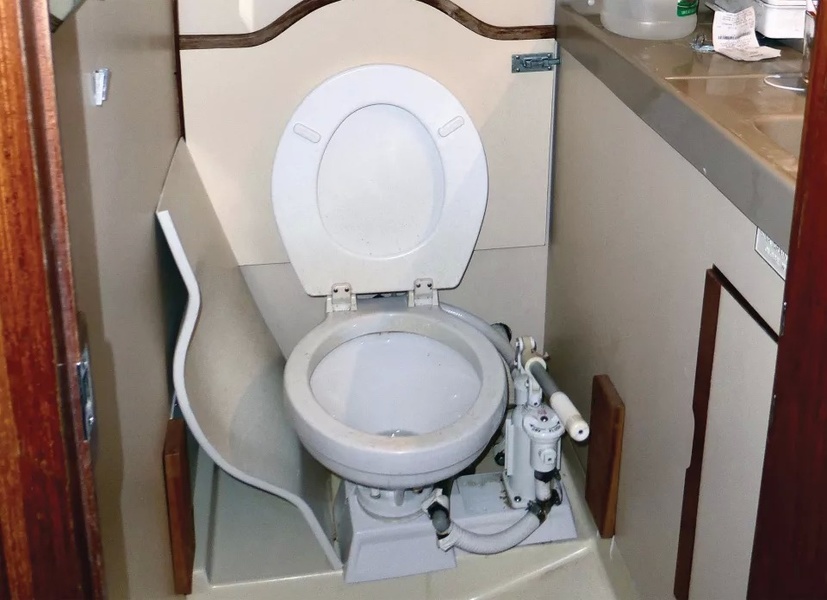
One head is good, but a lot is better.
Eventually I decided to replace the whole system, including the old man. In the process of measuring the pipeline, I called in parallel every board I used to walk on and where there were latrines with electric drive.
Not so long ago it wasn't rational to put up motorized yacht turrets. They consumed too much electricity, were noisy and broke down all the time. I remember one that sounded more like a concrete mixer. After these impressions, I put an end to them. But after a while I saw a completely different picture: the newer model was almost silent and did not consume much electricity. And the owners were positive about its reliability. The situation has changed since then, and the more I thought about the idea, the more I liked it. I started looking for the right option.
We'll weigh the pros and cons
On the positive side, it is worth noting:
- the compact size of the shredder, which is built into the design; - the
use of less water for rinsing
;
- the
entire procedure is carried out at the touch of a button, and therefore everyone can cope with it;
- the bowl is usually larger than analogues with manual drive, which is not less important.
The disadvantages are:
- Still, this is the consumption of battery power;
- Noise
; - Price;
- Complex layout, some are equipped with two electric motors.
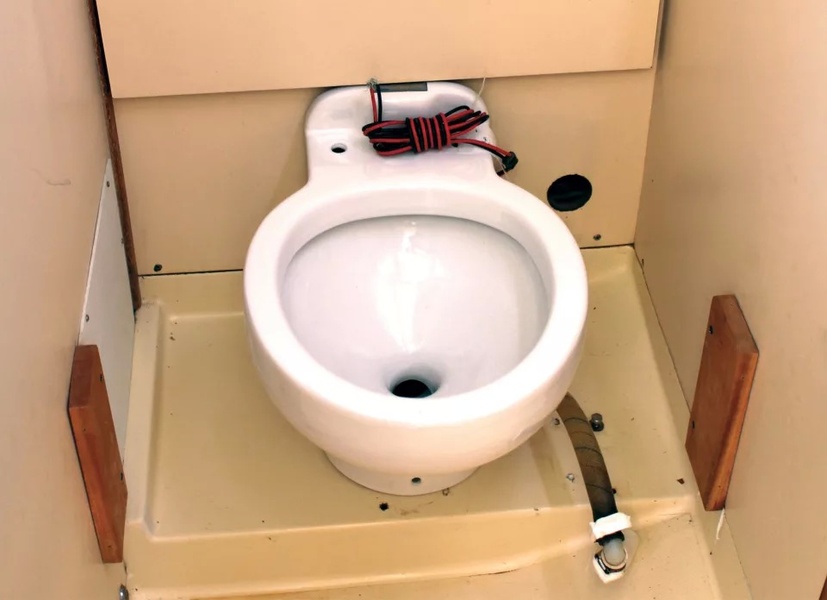
The first thing you pay attention to when searching for a suitable candidate is a variety of choices. Most manufacturers have a range of several models. Even the most demanding yachtsman can choose from a variety of models. Manual or electric, with one or two pumps, different in terms of system voltage and color, bowl and seat size. Some models are suitable for fresh water, some for marine use.
Don't make a rash purchase.
The best place to pick up a latrine, of course, would be a boot show. It will be easier to navigate among a wide range of products, from dwarfs to the usual home size. The choice will depend on a huge number of variables. You need to make sure that you can mount the one you like, given all the associated piping and electrical work, to understand whether you need additional connections, adapters; if there are separate pumps, there is a place to place them. And that's just a small part.
If you stop at a motorized garage, remember that you need batteries of sufficient capacity, especially if the crew is large. And the starting current of the electric motor can reach 20-30 A and more.
When choosing between a manual drive and an electric drive, the following should be noted. The integrated shredder must do its job perfectly, quickly and without unnecessary power consumption. Those models in which clean water is supplied by one pump, and for pumping is another with a shredder, perform better washing. Some manufacturers claim that 0.5 litres of water is used for one wash, which sounds good. The control can vary from on/off to setting the duration of each mode separately.
Most optionally offer nozzles for fresh or salt water, which will be pressurized to flush the bowl. The former eliminates the possibility of odour due to dead sea life, but because there is not much fresh water on board, it is more suitable for yachts with desalters.
In terms of reliability, I had my doubts about the electric drive of the pump. In order to understand the situation, I conducted a survey among yachtsmen familiar with this type of unit. As I later noticed, anyone who spoke badly about electric drive was not using it on their board, but based their judgment on someone else's opinion. Those who had it were quite satisfied with their decision and noted that the difference in reliability compared to the manual drive is not significant. But there is one «thing»: if you have one latrine on board and it is electrically powered, you must have a spare pump or bucket, which must be ready. In my case, there's another latrine in the nose and it's hand-operated, so I'm not worried that the electric one might break down.
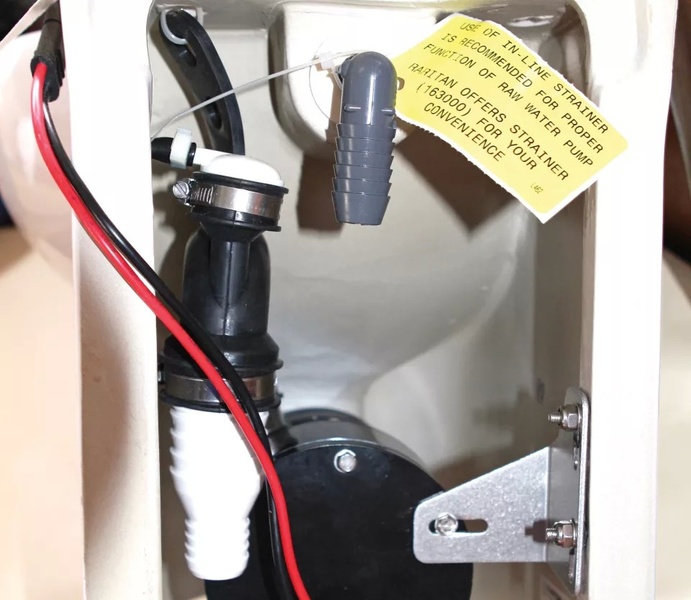
To avoid electrical problems, comply with all conditions that are specified in the instructions for wire cross-section, maximum current on the packets. Check that the wires are tightly crimped and laid in the case. Remember to install a filter in front of the water supply pump, which will prevent clogging of the system and breakage of an expensive pump.
If you, like me, get rid of all the old piping coming from the latrine during replacement, make sure that all connections fit the diameter from the latrine to the scuppers. Some latrines are equipped with a ½" water supply pipe and a 1" outlet pipe, while most are equipped with ¾" and 1 ½" spigots respectively. Note the Shields, Trident accessories. They make a quality product that will really stand up to the frequent removal and installation of sockets, given that they will sometimes have to be heated with a hair dryer. I chose Raritan's Saniflex as my best solution and it is easy to bend it into the right shape and put it on a ruffle spike.
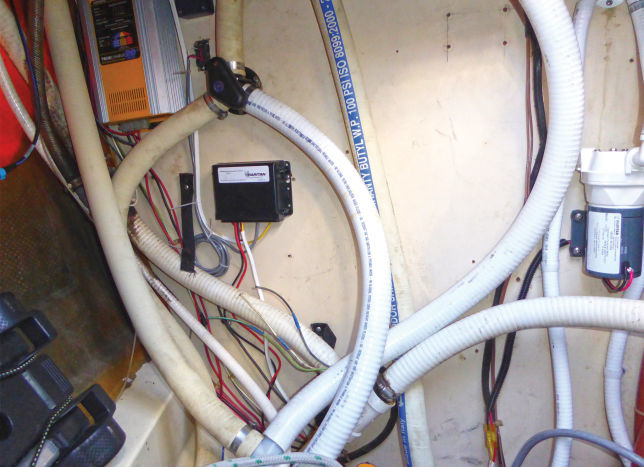
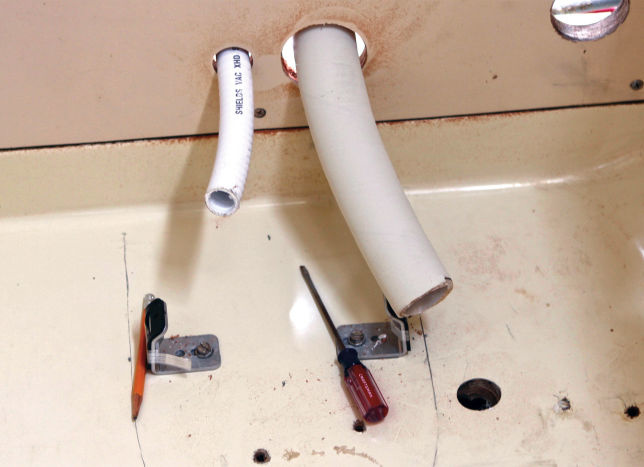

We're coming to the end of the work.
This kind of modernization is best done in winter. After reviewing all the models I have presented, I decided on the Raritan Marine Elegance, which combines most of the requirements for the desired equipment. It is almost the same size as the domestic one, has a semi-soft lid, is rinsed with salt water (fresh optional), a powerful shredder is hidden in the bottom of the latrine, and has a water shutter to prevent odors from entering the storage tank.
Surprisingly, the installation proved to be quite simple. I dismantled and threw out the electrically driven shredder pump, which had previously emptied the storage tank (to replace it with a manual pump). Soon, the wire with a sufficient cross section and the switch were already in place to connect the new garage. I had to make a few holes to mount the controller on the rear side of the garage bulkhead and to install the control panel on the front. The wires from the two pumps were connected to the controller, and the controller was already connected to a 20A bag.
The latrine is supplied with a base, which is pre-mounted on an adhesive template. All I have to do is to place this design in the right place and drill holes and then shake off. Then, following the instructions that came with the kit, I drilled new holes in the bulkhead for the water supply and recoil pipes. You have to work carefully here, because you had to drill almost blindly and you could be knocked down from the right place.
It turned out that I installed a water pump and filter on the back of the bulkhead, and there was also an antisyphon. How to connect the pump was described in the instructions I mentioned earlier. I personally followed her every word.
After installing the seat and connecting the feed and return pipes to the shredder, I inserted the bowl into the seat and removed all connections. This is the whole assembly process.
 After installing the Marine Elegance, the latrines began to have a very different appearance.
After installing the Marine Elegance, the latrines began to have a very different appearance.
Just the button and no unnecessary movements.

One press of the button fills and flushes the toilet. The noise is not as much as I expected, but it will wake you up with a midnight pumping rather than a pump. You need to hold the button for 5-7 seconds to fully pump, flush and fill the system with clean water, while the manual pump will have to do about 20 pumping to make sure the bowl contents passes the non-return valve. I did not notice any particular consumption on the batteries, nor did I notice any smell for at least the first 6 months of its use. Am I satisfied with my decision? Absolutely!
The article was written for Sail Magazine in December 2017. You can read the original here.

